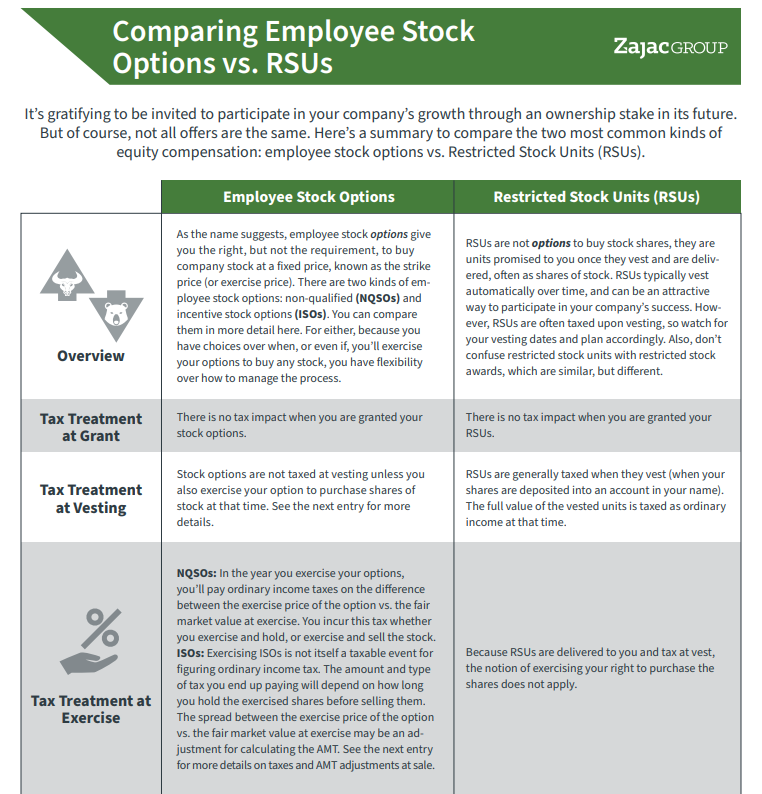
Coming up with “why” you might want to do a cash or cashless exercise of your stock options is easy. But equally important is knowing “how” to do your exercise.
When you exercise your employee stock options, you generally have a choice to do a cash exercise or a cashless exercise.
With a cash exercise, the goal is often to maximize the amount of stock you hold. All else being equal, a cash exercise allows you to retain more shares of stock than a cashless exercise.
Why Do a Cash Exercise Instead of a Cashless Exercise?
A cash exercise could make sense if you believe the stock price will go up. However, employee stock options do not guarantee a stock price that goes up. In fact, it is possible that your stock price can go down and that you can lose some, or all, of your money.
A cash exercise also means that you will need to come to the table with the requisite cash to buy shares (and maybe cover the pending tax due to your exercise). There may be several ways to obtain the cash you need due to the exercise, including but not limited to:
COMPARISON GUIDE
Not All Stock Offers are the Same! Here's a helpful comparison between two of the most common employee stock options.
- Using cash savings: If you’re lucky enough to have cash in the bank, you can use that cash to pay the associated costs.
- Using non-IRA investments: If you have other non-IRA accounts, you may be able to liquidate the investments to create the cash necessary to pay for the exercise. Before you do, think through the potential tax impacts you create (through capital gains or losses).
- Using a loan: Don’t have available cash or other investments to use but still want to do a cashless exercise? You could obtain a loan. Possible options may include a home equity line of credit or a margin loan on an investment account.
So, is it a good idea to use cash to exercise your employee stock options? Or is it better to do a cashless exercise?
Again, the idea behind a cash exercise is that you maximize the amount of stock you hold. But there are certain aspects of a cash exercise that makes it the riskier of the two exercise strategies.
Why? Read on and find out.
A Cash Exercise of Employee Stock Options May Increase Your Concentration Risk
When you implement a cash exercise of employee stock options, you need to have cash on hand to buy the stock options you exercise. Depending on the type of stock option you have, you may also need to have the cash to pay the tax due.
Let’s assume you want to exercise 10,000 employee stock options that have an exercise price of $5 per share. In order to buy the shares, you need pay $50,000 ($5 per share times 10,000 shares).
Let’s further assume that you use cash you have in a checking or savings account to pay for this $50,000. Using a chart to illustrate:
| Pre-Exercise | Post-Exercise | |
| Cash | $50,000 | $0 |
| Value of Options | $450,000 | $0 |
| Value of Stock | $0 | $500,000 |
| Net Worth | $500,000 | $500,000 |
| Stock as % of Net Worth | 90% | 100% |
After you perform the cash exercise, you will have $50,000 less in cash; that’s what you used to buy the shares. You also now control a total of $500,000 of your company stock, which is a $50,000 increase from the pre-exercise scenario.
If we then calculate and compare the value of the stock as a percentage of your net worth, you can see that your pre-exercise position is 90% of your net worth and your post exercise position is 100% of your net worth.
As seen in our simple example, the result of a cash exercise is typically an increase to your overall position in the company stock as it relates to your net worth. That increases your concentration risk and may leave you less diversified than you may want to be.
Its also important to know that this simple illustration only addresses the cost of the stock options, and not the potential tax due. You can learn more about the tax implications of employee stock options by reading here:
A Cash Exercise Puts You at Risk of Losing Your Money
When you own an employee stock option, you are under no obligation or requirement to exercise the shares. Your option to exercise is exactly as it sounds: an option, not a requirement.
Because you’re not required to exercise the option, and because you did not pay anything for the options, you have limited risk before you exercise.
If the stock price goes down and your options become worthless, you did not lose anything as you never put any of your money into the deal. This can be referred to as “paper risk,” as your account statement may go up and down, but it’s really only a number on paper.
When you exercise your stock options via a cash exercise, you put your money into the deal, changing paper risk into real risk. You literally take your own dollars and use them to buy stock.
Once you own stock, you are subject to market risk. That’s the risk that if the market goes down, you will lose not only the value of your stock, but the money you paid to exercise the stock option.
Continuing our example from above, let’s assume you paid $5 per share for stock that is worth $50 per share. In this example, your stock option would have had $450,000 of profit (this is gross profit, as income tax may impact this number).
In lieu of selling the shares, you decide to retain the stock as you believe it’s worth more than the current $50 per share; maybe you think it’s worth $100. But what if you’re wrong? Before you know it the stock price drops from $50 per share to $25, or $20, or worse.
As the stock price drops, you continue to see your wealth disappear. At $25 per share you are worth $250,000, half of the original amount. And at $20 per share, you are worth $200,000.
A worst-case scenario might be if the exercised stock drops so much that the price you paid is worth more than the current market price.
For example, imagine if the stock price goes to $3 per share. Now your original investment of $50,000, which was at one time worth $500,000, is now only worth $30,000. In this scenario, you would have actually lost money in the deal as your paid $50,000 for something that is only worth $30,000
(Not to mention, you may have even paid a greater amount of income tax on these transactions that would have otherwise needed to, which pushes you even more into the red).
To compare, imagine if you had never exercised your employee stock options. You would still have $50,000 in the bank, as you never needed it to buy the stock.
Therefore, if the market price of the stock drops from $50 per share (or $450,000 of value) to $3 per share (or $30,000) and the options become worthless, at least you never put your own money into the deal.
The Risks of Cash Exercises of Employee Stock Options Are Not Always Equal
In a simplified world, the potential increase in risk you assume with a cash exercise of employee stock options can be measured by the amount of cash you put into the deal. The more cash you put in, the more you increase your risk.
But your risk will also differ depending on a number of personal factors such as other financial resources, tax brackets, investment risk tolerance, age, and income.
For example, if your only asset is $100,000 cash and you use that to perform a cash exercise, your risk is materially higher than someone who uses $100,000 of the one million dollars’ worth of cash they have.
Similarly, a retiree who performs a cash exercise to accumulate assets in one stock may be assuming materially more risk than someone making the same decision in their 30s.
Is a Cash Exercise the Right Move?
All else being equal, a cash exercise is likely a riskier employee stock option exercise strategy because it often leads to a more concentrated equity position. And that higher equity exposure may increase the likelihood of greater volatility.
It is also riskier because a cash exercise means putting your own money into the deal, which becomes money that you can lose if the stock price goes down.
An alternative to a cash exercise for those who do not want to assume the risk is a cashless exercise. In a cashless exercise, you simultaneously exercise and sell some or all of your stock options. The stock options you exercise and sell for a profit are used to cover the requisite cash call.
The two major differences with a cashless exercise are that you can A. calculate the math so you are not required to bring cash to the table, and B. your stock holding is lower post exercise, as you needed to exercise and sell some to pay for the transaction.
For those with the appropriate risk appetite and/or personal financial planning needs, a cash exercise may be the right move. For others, a cashless exercise that limits your equity exposure and the cash required to exercise the shares may be more suitable.
And for those who aren’t exactly sure, a good financial advisor and team of professionals may be able to help.
This material is intended for informational/educational purposes only and should not be construed as investment, tax, or legal advice, a solicitation, or a recommendation to buy or sell any security or investment product. Hypothetical examples contained herein are for illustrative purposes only and do not reflect, nor attempt to predict, actual results of any investment. The information contained herein is taken from sources believed to be reliable, however accuracy or completeness cannot be guaranteed. Please contact your financial, tax, and legal professionals for more information specific to your situation. Investments are subject to risk, including the loss of principal. Because investment return and principal value fluctuate, shares may be worth more or less than their original value. Some investments are not suitable for all investors, and there is no guarantee that any investing goal will be met. Past performance is no guarantee of future results. Talk to your financial advisor before making any investing decisions.







Suggest putting the withheld income tax into these numbers, it can be much more than the stock strike price x shares.
Thanks, Ben – I added a few tax links for non-qualified and incentive stock, as the tax impact might be meaningfully different.